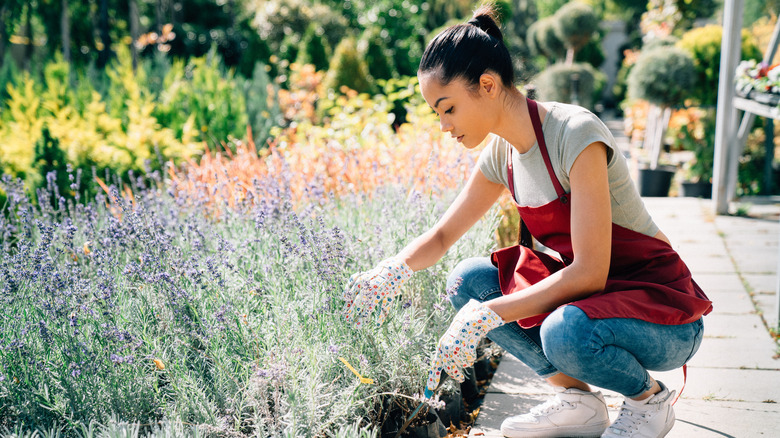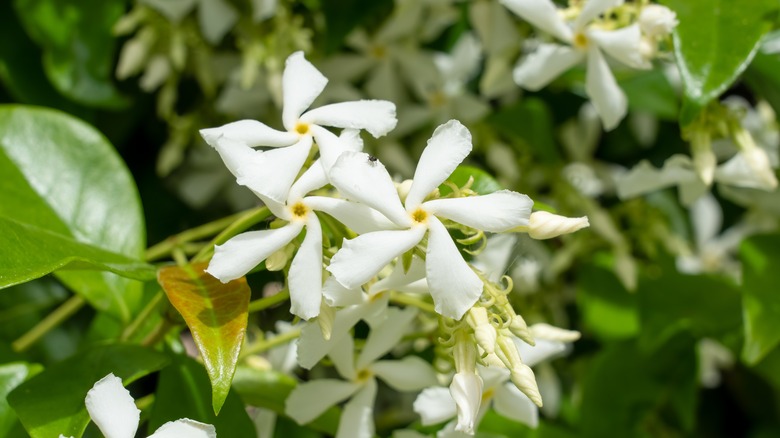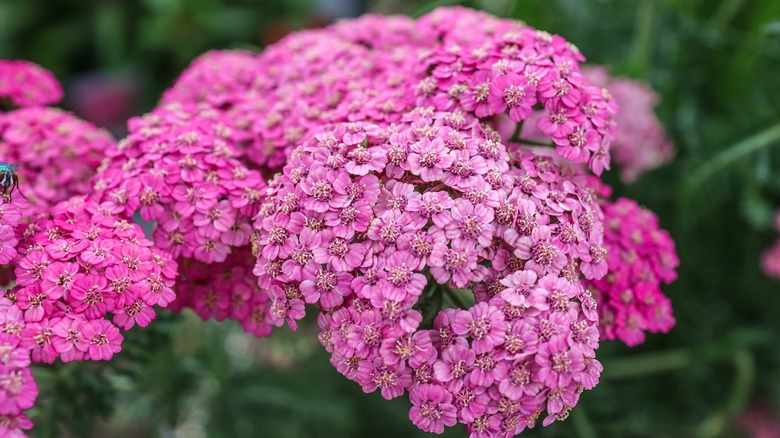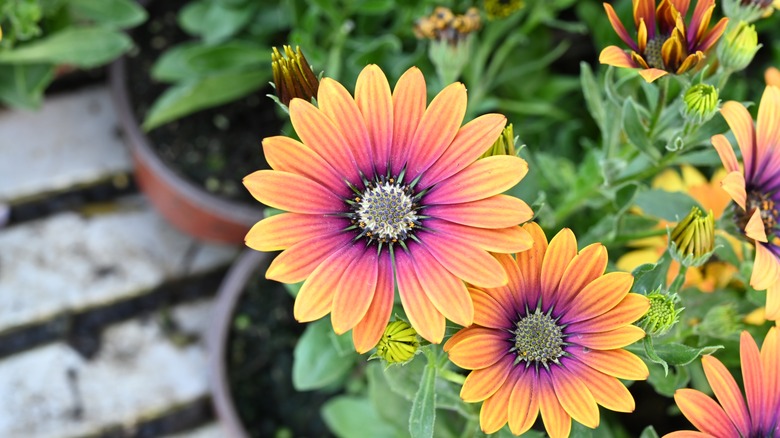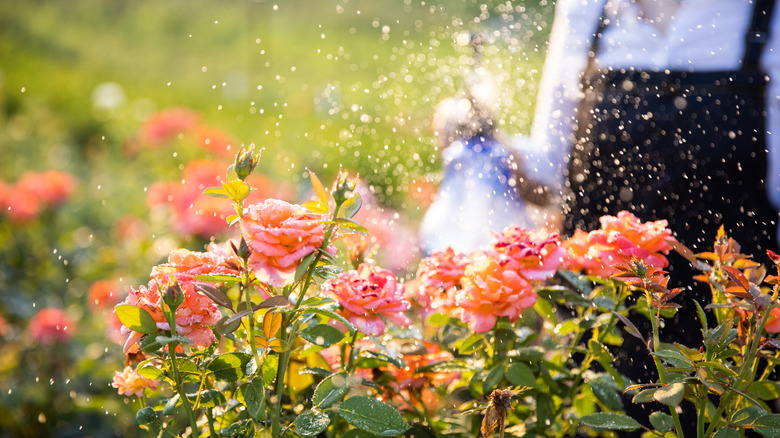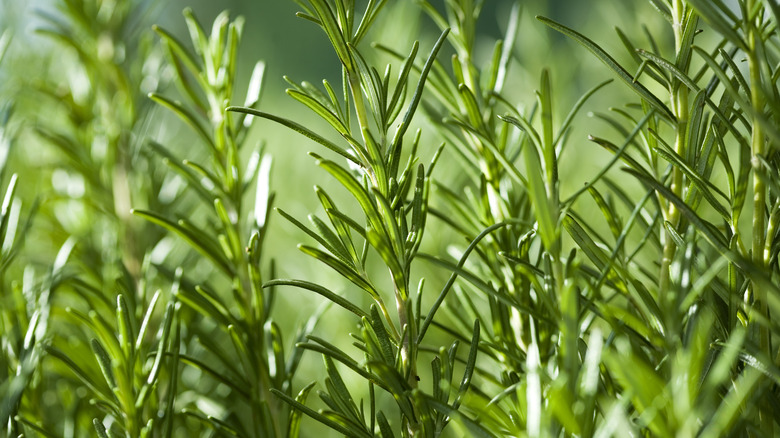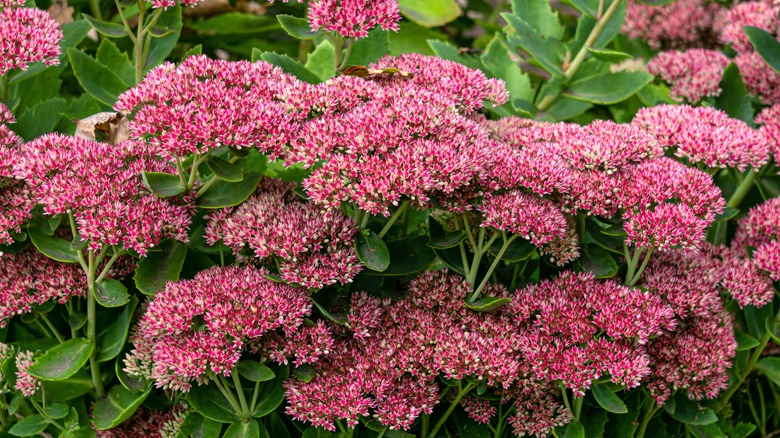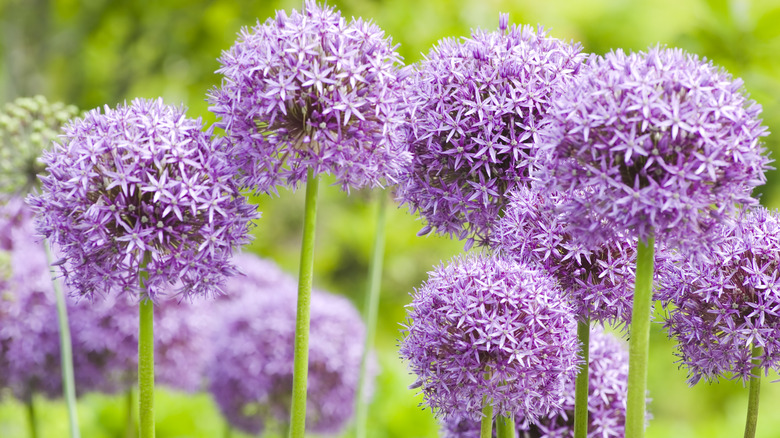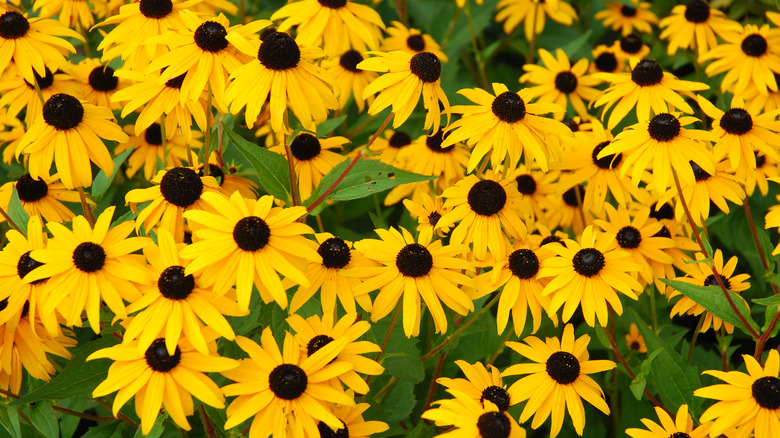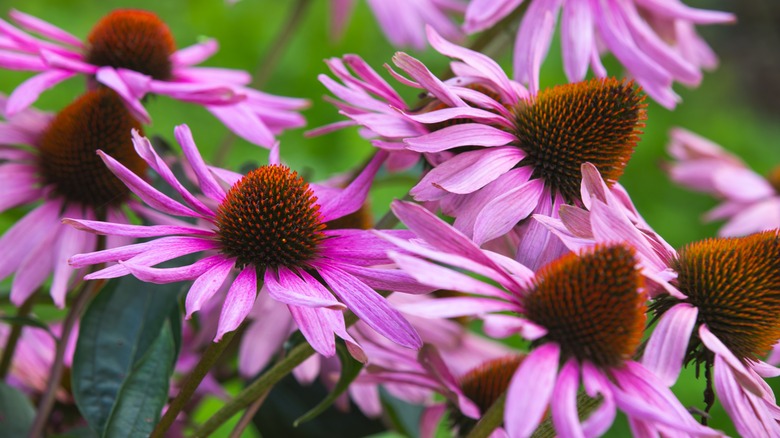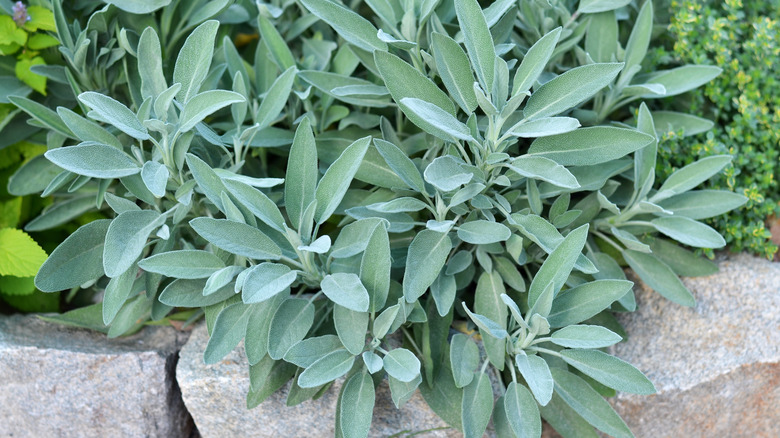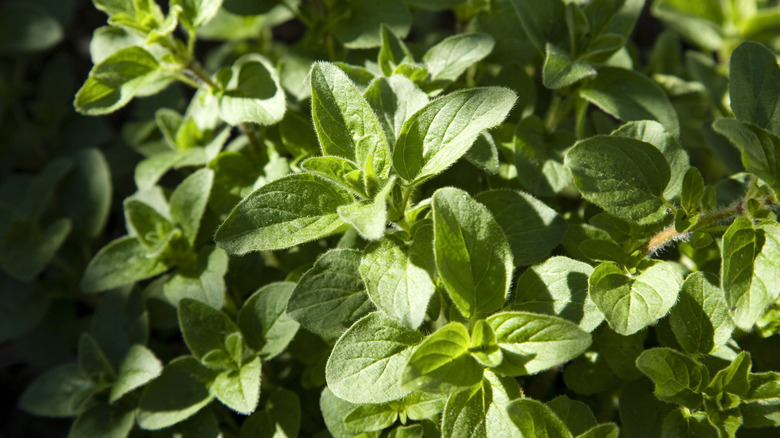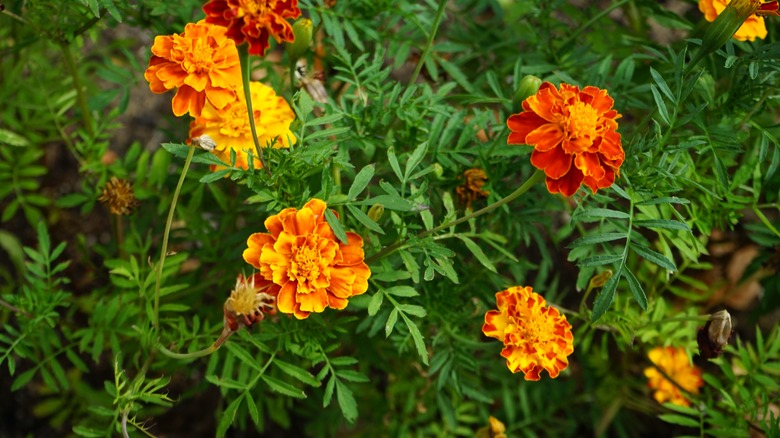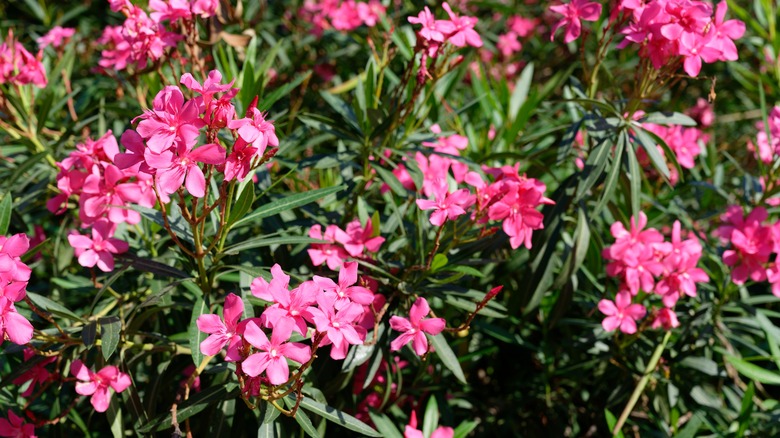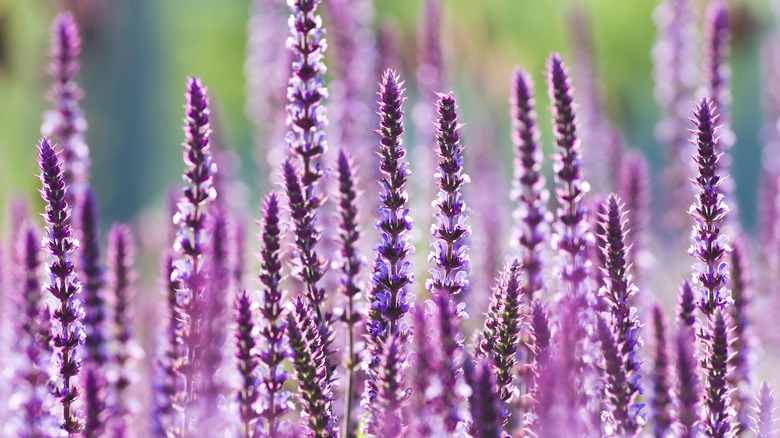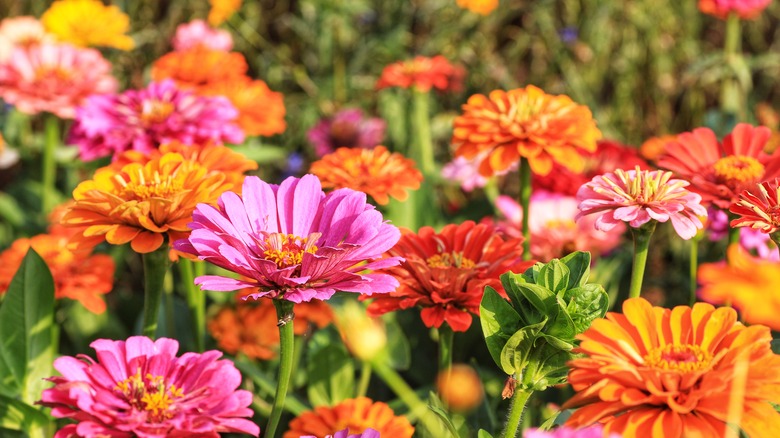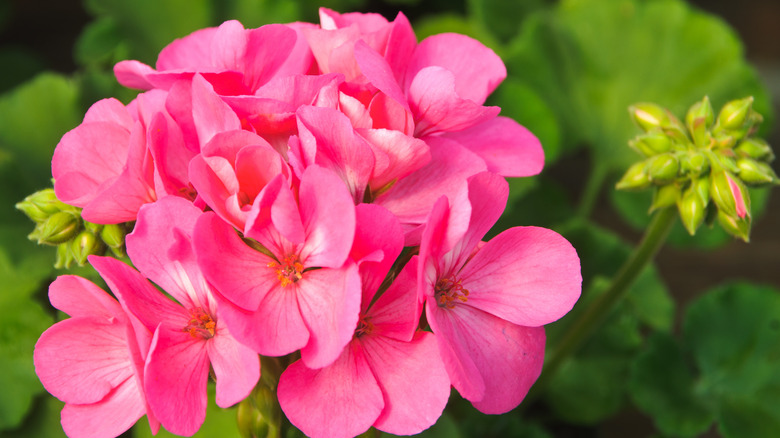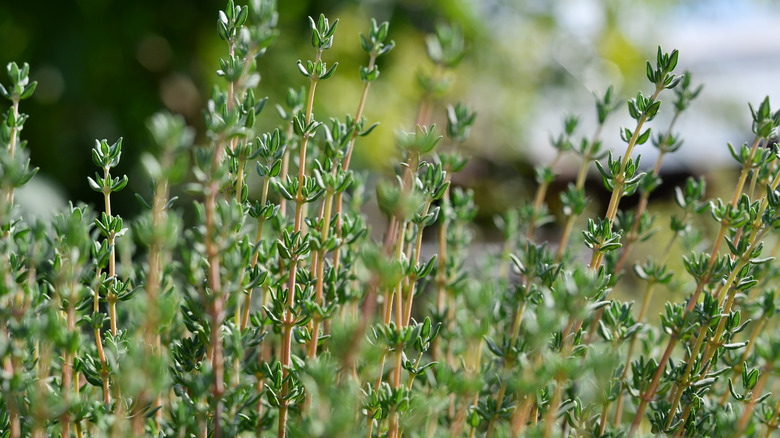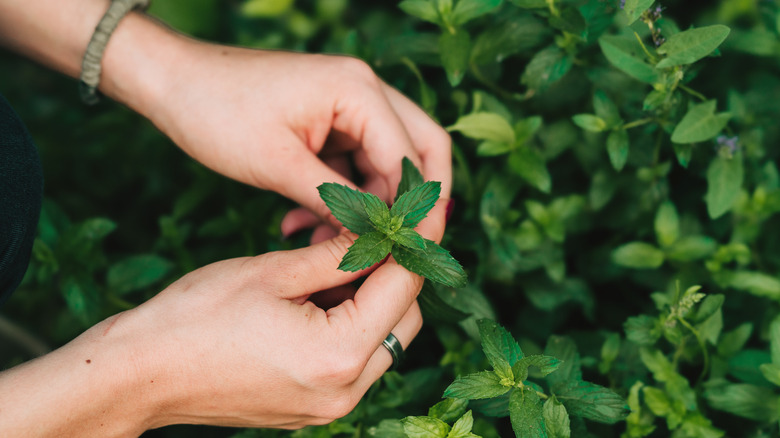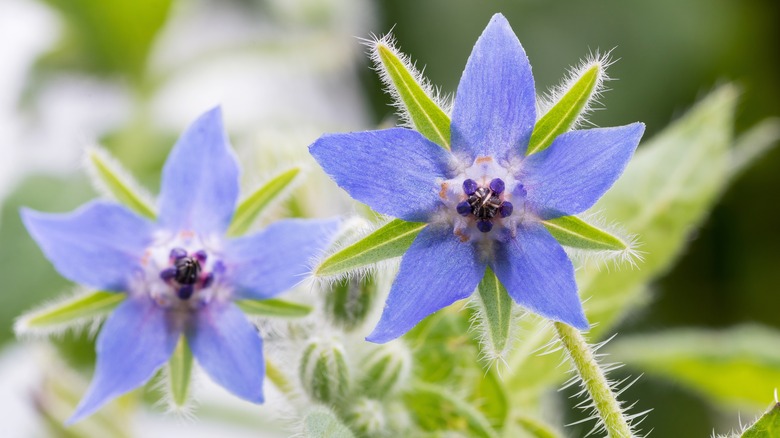19 Beautiful Plants That Pair Nicely With Lavender In The Garden
Lavender (Lavandula) has been a popular perennial herb for over 2,500 years, and it's easy to understand why — it's colorful, fragrant, and suitable for gardeners of all skill levels. It makes a beautiful border plant and an even better herb garden addition. And, because of its soil, water, and light requirements, lavender is a great companion plant to many other plants with the same needs. Companion planting benefits nearby plants by contributing to soil health, deterring pests, attracting pollinators, and suppressing weeds. We've put together a list of 19 plants that pair nicely with lavender.
Our list is full of plant species that share some, if not all, growing conditions with lavender. When selecting the perfect companion species, consider your garden, the sunlight it gets, and the soil. While many of these plants thrive in full sun, some will need a few hours of shade. Like lavender, many of these plants are drought-resistant and need well-draining soil to prevent root rot. Choose companion plants that won't need much more care than your lavender, and you'll have a beautiful, thriving garden with minimal effort.
Jasmine
Like lavender, jasmine (Jasminum officinale) is beloved for its fresh scent. Planting the two together will invite pollinators like bees and butterflies, who will, in turn, help all of your plants grow. Both jasmine and lavender need full sun, though jasmine also needs partial shade. So, plant your jasmine near your lavender, but far enough to have some hours without direct sunlight.
Bloom Season: Spring
USDA Growing Zone: 7 to 10
Growing Conditions: Full sun, partial shade
Soil Type: Loamy and well-draining with organic material and an acidic or neutral pH
Size: Up to 4 feet tall and 7 feet wide
Yarrow
Yarrow (Achillea millefolium) has many of the same growing requirements as lavender. That makes them excellent companion plants. They look beautiful alongside each other in butterfly and border gardens. They're drought-tolerant, too, making them a great choice if your area experiences periods without rain.
Bloom Season: Summer through fall
USDA Growing Zone: 3 to 9
Growing Conditions: Full sun
Soil Type: Moist and well-draining with a neutral pH
Size: 2 to 3 feet tall and wide
African Daisy
Like lavender, African daisies (Arctotis hybrida) are an easy-to-grow plant that needs full sun and tolerates drought. They have brightly colored blooms that will complement the gorgeous purple cover of lavender. Plant them near your lavender for a showy garden display.
Bloom Season: Spring through fall
USDA Growing Zone: 10 to 11
Growing Conditions: Full sun
Soil Type: Moist and well-draining with an acidic pH
Size: 1 to 3 feet tall and 1 to 2 feet wide
Roses
There are many types of roses (Rosa rubignosa), all of which make stunning additions to a garden. They spread wide, so they should be planted at least 24 inches apart from their lavender neighbors. That way, they can enjoy the same amount of sun without encroaching on other plants.
Bloom Season: Late spring to early fall
USDA Growing Zone: 4 to 8
Growing Conditions: Full sun
Soil Type: Moist and well-draining, with a pH of 6.0 to 7.0
Size: 2 to 9 feet tall and 2 to 15 feet wide
Rosemary
Delicious and easy to grow, rosemary (Rosemarinus officinalis) is a popular companion herb. Rosemary and lavender thrive in sunny spots and well-draining soil, making them a breeze to grow together. Be sure to select a cultivar that will tolerate your region's weather. There are several cultivars, some of which can withstand freezing temperatures.
Bloom Season: Spring and summer
USDA Growing Zone: 8 to 10
Growing Conditions: Full sun
Soil Type: Well-draining, loamy, or sandy, with an acidic to neutral pH
Size: 2 to 6 feet tall and 2 to 4 feet wide
Sedum
Sedums, also called stonecrop, are succulents that have a lot in common with lavender. They share soil, light, and water requirements. Wherever you can plant lavender, you can also plant sedums. They're a low-growing plant that will help suppress invasive species of weed and limit competition in your garden.
Bloom Season: Summer through fall
USDA Growing Zone: 3 to 10
Growing Conditions: Full sun, will tolerate partial sun
Soil Type: Well-draining, loamy, or sandy with an acidic or neutral pH
Size: 6 to 24 inches tall and 1 to 2 feet wide
Allium
Also called ornamental onions, alliums have beautiful purple blooms that pair well with the bright color of lavender. Consider planting both plants together in a border garden that receives plenty of sunlight. Though you can grow them from seed, they'll take less time to germinate if grown from bulb offsets.
Bloom Season: Spring
USDA Growing Zone: 4 to 9
Growing Conditions: Full sun
Soil Type: Well-draining with an acidic pH
Size: 1 to 4 feet tall and 3 to 10 inches wide
Black-eyed Susan
Black-eyed Susans (Rudbeckia hirta) are charming yellow flowers with a daisy-like appearance. Not only do black-eyed Susans share the same water, soil, and light needs as lavender, but they're also a complementary color. The bright yellow will perfectly complement the rich purple in a garden.
Bloom Season: Spring through fall
USDA Growing Zone: 10 to 11
Growing Conditions: Full sun, will tolerate partial
Soil Type: Loamy and well-draining, rich in organic matter, and has an adjustable pH
Size: 3 to 8 feet tall and 3 to 6 feet wide
Coneflower
If you want a sea of purple, consider pairing your lavender with purple coneflower (Echinacea purpurea). It does not require as much sun as lavender, so it's best planted between lavender and a shady spot. It also makes for an attractive addition to a perennial border garden.
Bloom Season: Summer
USDA Growing Zone: 3 to 8
Growing Conditions: Full sun, partial shade
Soil Type: Moist and well-draining with an acidic or neutral pH
Size: 2 to 5 feet tall and 1 to 2 feet wide
Sage
Sage (Salvia officinalis) may seem like a poor match for showy lavender, but it can actually serve as a beautiful ornamental plant. It pairs well with lavender due to its similar needs. While it doesn't have a wide spread, it will still grow best when planted between 18 and 24 inches apart from its neighbors.
Bloom Season: Summer
USDA Growing Zone: 4 to 10
Growing Conditions: Full sun
Soil Type: Well-draining and loamy or sandy with an acidic to neutral pH
Size: 2 to 2 ¼ feet tall and wide
Oregano
Growing the delicious oregano (Origanum vulgare) is easy. It's tolerant to drought, poor soil, and erosion. Though oregano and lavender have their own acceptable pH range, they will both thrive in well-draining soil with a neutral pH of about 7.0. Plant them where they'll receive enough sun and they'll grow together in harmony.
Bloom Season: Summer
USDA Growing Zone: 4 to 10
Growing Conditions: Full sun
Soil Type: Well-draining with an acidic or neutral pH
Size: 1 to 2 feet tall and 1 to 1 ½ feet wide
Marigold
The vibrant color of marigolds (Tagetes spp.) pairs well with the delicate purple of lavender. Both plants also enjoy hours of bright sunlight and will grow well in neutral soil. As a companion plant, marigolds deter pests that may otherwise harm your lavender.
Bloom Season: Summer
USDA Growing Zone: 2 to 11
Growing Conditions: Full sun
Soil Type: Well-draining with a slightly acidic to neutral pH
Size: 4 inches to 4 feet tall and 6 inches to 2 feet wide
Oleander
The grand oleander (Nerium oleander) may seem more like the star of a garden rather than a companion plant. However, it has the same needs as lavender and offers a unique soft texture that juxtaposes lavender's tall and narrow plumes. Plant them within the same soil, but spread them out enough to allow the oleander to root and grow. It is worth noting that oleander is not recommended if you have pets or little ones who may want to eat parts of the plant. It is poisonous when ingested.
Bloom Season: Spring through summer
USDA Growing Zone: 8 to 10
Growing Conditions: Full sun, will tolerate partial sun
Soil Type: Well-draining with an alkaline pH
Size: 8 to 9 feet tall and 6 to 10 feet wide
Salvia
Salvia is widely used in garden beds because it is an effective, low-maintenance companion plant. Though it prefers soil with an acidic pH, it will tolerate a neutral pH of 7.0. So, it can grow in the same bed as your lavender. A salvia and lavender garden will not only look stunning, it'll attract all manner of pollinators too.
Bloom Season: Summer
USDA Growing Zone: 4 to 8
Growing Conditions: Full sun
Soil Type: Well-draining with an acidic pH
Size: 1 to 2 feet tall and 1 to 1 ½ feet wide
Zinnia
If you want a colorful flower bed, a combination of lavender and zinnias (Zinnia elegans) will really pop. The fast-growing zinnias come in a variety of colors and are beginner-friendly. They, like lavender, thrive in direct sunlight for at least eight hours a day and prefer a neutral soil pH. Plant them at least eight inches apart to give them room to grow.
Bloom Season: Spring through fall
USDA Growing Zone: 3 to 10
Growing Conditions: Full sun
Soil Type: Well-draining with a neutral pH
Size: 1 to 4 feet tall and 6 to 18 inches wide
Geranium
Like zinnias, geraniums are also colorful and easy to grow. Pairing them with lavender is beneficial, but routine soil monitoring will be necessary as geraniums do prefer a 6.5 pH, which is slightly acidic when compared to the 7.0 pH that lavender enjoys. They will grow in neutral soil so long as their other requirements are met. You can also grow them near, but not adjacent to, lavender in order to control their soil pH separately.
Bloom Season: Spring through fall
USDA Growing Zone: 9 to 11
Growing Conditions: Full sun, partial shade
Soil Type: Well-draining with organic matter and an acidic pH
Size: 1 to 3 feet tall and wide
Thyme
Thyme (Thymus) is a cold-hardy herb similar to lavender, and it's perfect for growing in a backyard garden. While other plants may not tolerate winter temperatures, thyme and lavender will continue to thrive. Thyme tolerates any soil pH and, once established, is drought-resistant. Additionally, some species, like creeping thyme, provide ground cover that suppresses weed growth and deters pests.
Bloom Season: Spring and summer
USDA Growing Zone: 5 to 9
Growing Conditions: Full sun
Soil Type: Well-draining, loamy or sandy, and with an acidic, neutral, or alkaline pH
Size: 6 to 12 inches tall and wide
Mint
Mint (Mentha spp.) is an easy-to-grow companion plant for lavender and other herbs. Create a diverse and delicious herb garden by planting mint, lavender, thyme, and rosemary. Spread mint out about 12 inches from other plants so it can root and grow and harvest as needed. Mint is fast-growing but capable of overrunning a garden.
Bloom Season: Summer
USDA Growing Zone: 3 to 11
Growing Conditions: Full sun or partial sun
Soil Type: Well-draining and loamy with an acidic or neutral pH
Size: 1 to 1 ½ feet tall and 1 ½ to 2 feet
Starflower
Starflower or borage (Borago officinalis) has vivid blue flowers that look radiant when planted with deep purple lavender. Both plants do best in direct sunlight, and starflowers will tolerate the neutral or alkaline soil that lavender needs. In fact, starflower is a forgiving plant known to tolerate poor soil conditions. It's also considered a cover crop, meaning it will suppress weeds and limit pest activity.
Bloom Season: Summer
USDA Growing Zone: 2 to 11
Growing Conditions: Full sun, partial sun
Soil Type: Well-draining with an acidic, neutral, or alkaline pH
Size: 1 to 3 feet tall and 9 to 18 inches wide
